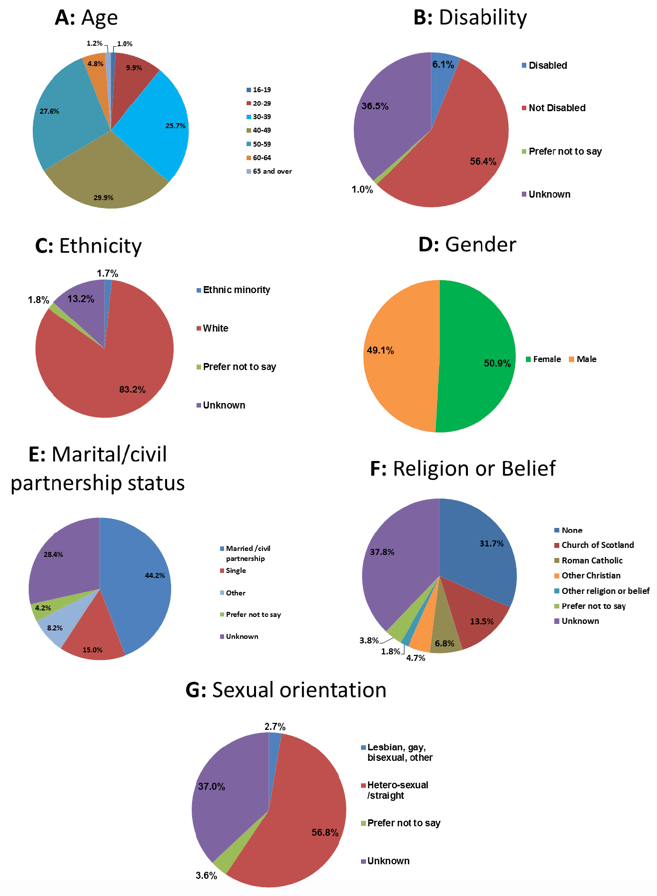Scottish Government workforce information 2016
Statistics on the Scottish Government’s workforce for each quarter from 2012 up to the most recent quarter at the end of 2016.
4. Diversity of directly employed staff
4.1 The Scottish Government collects diversity data set out in the Equality Act 2010. These include age, disability, ethnicity, gender, marital status, religion or belief, and sexual orientation. The two other protected characteristics are gender reassignment and pregnancy/maternity. The Scottish Government collects no information on gender reassignment. This is something that is currently being considered in conjunction with transgender organisations. Administrative information is collected on the protected characteristics of maternity and pregnancy for payroll purposes, when staff go on maternity leave. Information on the FTE number and headcount of staff on paid parental leave are presented in Table 1 and Annex E table C1.
4.2 Information on age and gender are collected and retained from all directly employed staff, for legislative reasons. Information on remaining characteristics is provided by employees on a voluntary basis. Currently, diversity information is not complete for all strands and therefore caution should be taken when interpreting the results, especially trends over time.
4.3 The Scottish Government is committed to improving the monitoring of the diversity of its staff whilst noting that the data is provided voluntarily. It is seeking to better understand the workforce by using targeted communications and awareness-raising to enhance the quality and quantity of our data monitoring. As a result declaration rates have improved for ethnicity (86.8 per cent), religion (62.2 per cent) and sexual orientation (63.0 per cent) at the end of 2016 ( Table 6, Table 9, and Table 10 respectively).
4.4 At December 2016 1.9 per cent of staff who declared an ethnicity were from ethnic minorities ( Table 6). This compares to 4.6 per cent for the population of Scotland aged 16-64 (Scottish Survey Core Question 2015).
4.5 The declaration rate for religion has increased by 9.3 percentage points since December 2015, though 37.8 per cent still have not declared this information ( Table 9). Of those who made a declaration most reported having no religion (51.0 per cent), followed by being Christian (40.2 per cent) and having an other religion or belief (2.8 per cent) ( Table 9). The results follow a similar pattern to the Scotland level results of the 2015 Scottish Survey Core Question (16-64 year old population, 52.9 per cent no religion, 42.5 per cent Christian, 1.8 per cent other).
4.6 The proportion of those completing their sexual orientation information has increased by over 13 percentage points since March 2015, though 37.0 per cent of the workforce have yet to supply this information ( Table 10). Of those who have declared, the proportion identifying as Lesbian, gay, bisexual and other is 4.2 per cent ( Table 10). This is higher than the proportion reported by the 2015 Scottish Survey Core Question for 16-64 year olds (2.0 per cent).
4.7 A significant proportion of staff still haven't provided their disability information (36.5 per cent, December 2016) ( Table 5). The unknown category has increased over time and, although it has decreased during the last year, it is still 5.1 percentage points higher than it was in March 2012 (31.4 per cent). The not disabled group has seen a corresponding decrease of 7.5 percentage points in the same period, from 63.9 per cent to 56.4 per cent, which is unlikely to reflect a real fall in the percentage of non-disabled staff ( Table 5). These changes are likely to be due to an error in the way in which categories were updated at a system level in 2012, and caution should be used when interpreting the results.
4.8 There has been a 3.6 percentage point increase in the proportion of people, who have declared disability information, identifying themselves as having a disability (6.1 per cent March 2012, 9.7 per cent December 2016 ( Table 5). Comparator information for disability is difficult to source due to question wording and the categories used, as well as questions often asking about long-term conditions rather than disabilities specifically. According to the 2015 Scottish Survey Core Question 18.2 per cent of 16-64 year olds had a limiting long-term physical or mental health condition.
4.9 Just over half of the workforce is female (50.9 per cent December 2016), this is an increase of 1.6 percentage points from March 2012 when it was 49.3 per cent ( Table 7).
4.10 The number of 16-19 year olds has increased over the last 5 years from 13 (March 2012) to 53 (December 2016) ( Table 4). This increase in the headcount is mostly due to the recruitment of modern apprentices.
4.11 The Scottish Government is committed to employing modern apprentices. Since the start of the scheme in January 2011, the core Scottish Government has taken on 264 Modern Apprentices. Of these 184 have converted to permanent members of staff, 47 were still completing their apprenticeship at the end of December 2016 and 33 left the organisation before completing their apprenticeship. Although Modern Apprentices are employed on fixed term contracts it is expected that they will become permanent employees on completion of the programme and passing a competitive selection interview.
4.12 The majority of staff were aged 30-49 (55.5 per cent in December 2016), while 33.6 per cent were aged 50 and over ( Table 4). Over time there has been a gradual decrease in those aged 30-49 and an increase in staff aged 50 and over, perhaps, due to an aging population and the removal of a fixed retirement age.
Chart 4. Diversity of directly employed staff at the end of December 2016

Contact
Email: Shona Rennie
There is a problem
Thanks for your feedback